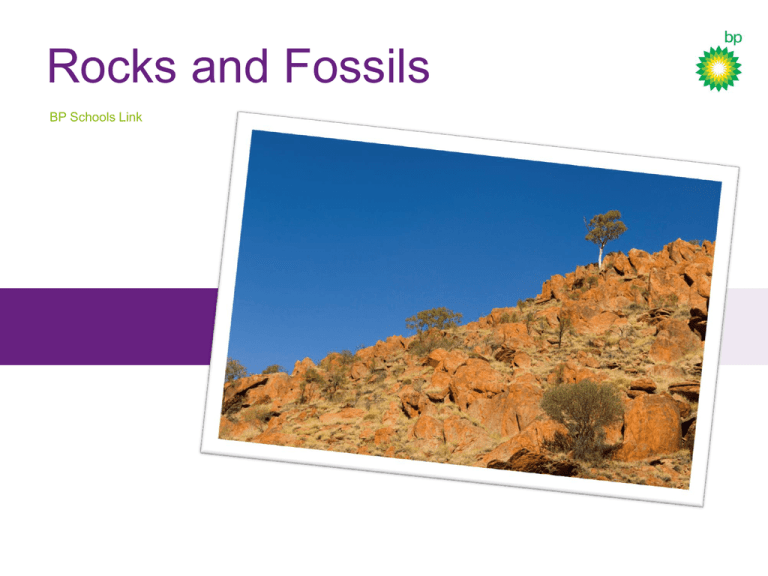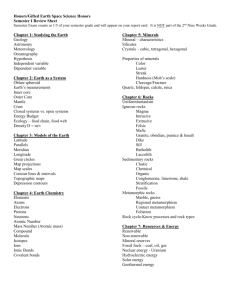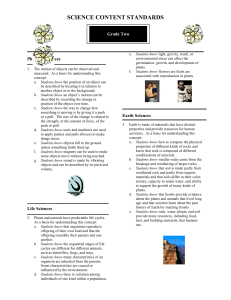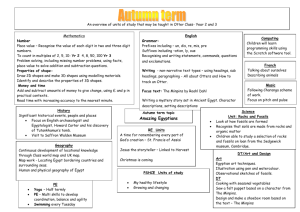Rocks and fossils presentation
advertisement

Rocks and Fossils BP Schools Link Pic 1 BP Schools Link – Rocks and Fossils 2 Pic 2 BP Schools Link – Rocks and Fossils 3 Pic 3 BP Schools Link – Rocks and Fossils 4 Pic 4 BP Schools Link – Rocks and Fossils 5 The formation of gas and oil BP Schools Link – Rocks and Fossils 6 Groups of rocks There are three groups of rocks: Sedimentary Metamorphic Igneous Over millions of years they may change from one into another. This is called ‘The rock cycle’. BP Schools Link – Rocks and Fossils 7 The rock cycle BP Schools Link – Rocks and Fossils 9 Sedimentary rocks 1 Sedimentary rocks are formed when: Sediments settle More layers settle The pressure squeezes out air and water pockets Particles are brought closer together Underground water seeps through, depositing minerals These cement the particles into a solid mass BP Schools Link – Rocks and Fossils 10 Sedimentary rocks 2 Sedimentary rocks are formed in three main ways: When broken bits of pre-existing rock get laid down (e.g. sandstone) When salt and other substances are separated by evaporation (e.g. rock salt) When remains of dead plants and animals build up (e.g. coal) BP Schools Link – Rocks and Fossils 11 Sedimentary rock samples Oolitic Limestone Mudstone Sandstone Limestone Chalk Desert Sandstone Conglomerate BP Schools Link – Rocks and Fossils 12 Metamorphic rocks 1 Metamorphic rocks are formed when: Heat and/or increased pressure affects existing rocks These rocks become re-crystallised as a result, but they don’t melt BP Schools Link – Rocks and Fossils 13 Metamorphic rocks 2 Most metamorphic rocks are formed by: ‘Regional’ processes, deep in the Earth’s crust ‘Thermal’ processes, where great heat from the magma (molten rock) affects the nearby rocks BP Schools Link - Build a Rig 14 Metamorphic rock samples Mica Schist Slate Banded Gneiss White Marble BP Schools Link - Build a Rig 15 Igneous rocks 1 Most igneous rocks are formed when: Extreme heat partially melts the metamorphic rocks The molten rock rises and solidifies to form igneous rocks BP Schools Link – Rocks and Fossils 16 Igneous rocks 2 Igneous rocks are formed in two ways: Extrusive – when molten rock comes to the surface and cools very quickly Intrusive – when molten rock cools and solidifies slowly underground BP Schools Link – Rocks and Fossils 17 Igneous rock samples Granite Amygdaloidal Basalt (Basalt with minerals filling in the gas holes) Gabbro Dolerite BP Schools Link – Rocks and Fossils 18 The life of a fossil 1 1. Living creature 3. After months, covered in silt 2. Dead creature sinks to sea floor 4. After 1000s of years, under more sand BP Schools Link – Rocks and Fossils 19 The life of a fossil 2 5. Permineralisation – shell decays 6. After millions of years, shell is replaced 7. Movement in Earth’s plates brings fossil to the surface 8. After 150 million years, fossil is exposed BP Schools Link – Rocks and Fossils 20 What is a fossil? Any part of any living thing preserved within a rock after it has died It can be: A footprint A tooth or single bone A whole skeleton of an animal, insect or plant BP Schools Link – Rocks and Fossils 21 Fossil samples Fossils come in all shapes and sizes BP Schools Link – Rocks and Fossils 22 Where are fossils found? Just like you can press flowers in a flower press, layers of rock preserve plants and animals as fossils Most fossils are found in sedimentary rock BP Schools Link – Rocks and Fossils 23 How are fossils preserved? Hard parts of animals Soft parts of animals/plants Traces of animals/plants The impression of a living thing Soft parts leave carbon Drying out Where no decay has happened BP Schools Link – Rocks and Fossils 24 Fossil fuels 1 Why do we refer to oil, coal and gas as fossil fuels? Oil, coal and gas are formed from the remains of dead plants and animals – but they are not really fossils! They took a long time to form, in the past. We are using them faster than they can be replaced. BP Schools Link – Rocks and Fossils 26 Fossil fuels 2 As the remains of plants and animals were buried and trapped, some formed oil and gas: The rocks acted like a sponge, collecting the oil and gas, storing it in tiny pores Fossil fuels are mainly found in sedimentary rock BP Schools Link – Rocks and Fossils 27









